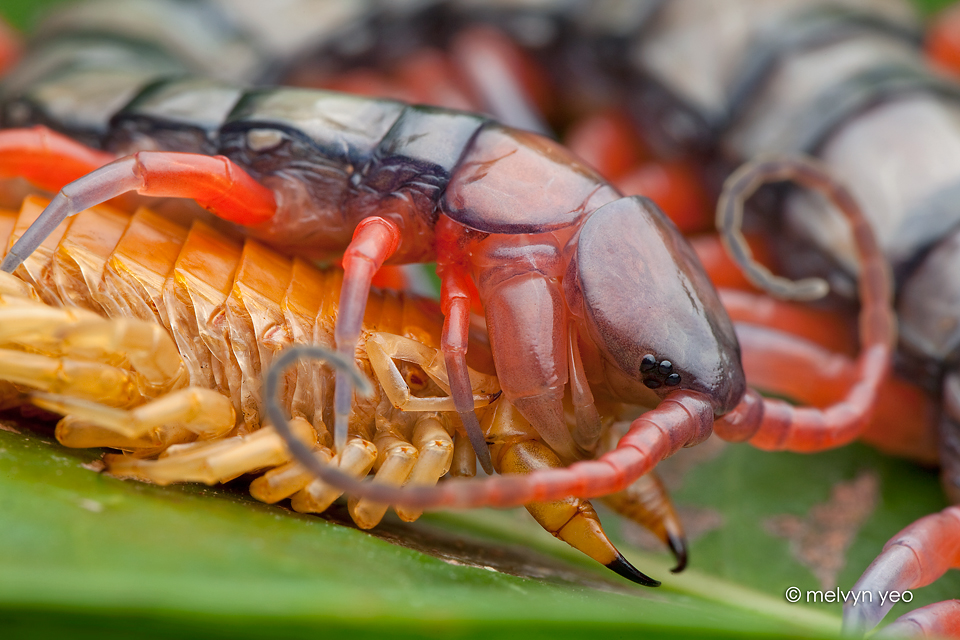ShopDreamUp AI ArtDreamUp
Deviation Actions
Description
Another angle of the centipede eating its exoskeleton. Taken at night in Singapore.


National Geo video www.youtube.com/watch?v=VcuFGs…
Quote from en.wikipedia.org/wiki/Centiped…
Centipedes have a rounded or flattened head, bearing a pair of antennae at the forward margin. They have a pair of elongated mandibles, and two pairs of maxillae. The first pair of maxillae form the lower lip, and bear short palps. The first pair of limbs stretch forward from the body to cover the remainder of the mouth. These limbs, or maxillipeds, end in sharp claws and include venom glands that help the animal to kill or paralyse its prey.[5]
Centipedes possess a variable number of ocelli, which are sometimes clustered together to form true compound eyes. Even so, it appears that centipedes are only capable of discerning light and dark, and not of true vision. Indeed, many species lack eyes altogether. In some species the final pair of legs act as sense organs similar to antennae, but facing backwards. An unusual sense organ found in some groups are the organs of Tömösváry. These are located at the base of the antennae, and consist of a disc-like structure with a central pore surrounded by sensory cells. They are probably used for sensing vibrations, and may even provide a sense of hearing.[5]
Forcipules are a unique feature found only in centipedes and in no other arthropods. The forcipules are modifications of the first pair of legs, forming a pincer-like appendage always found just behind the head.[6] Forcipules are not true mouthparts, although they are used in the capture of prey items, injecting venom and holding onto captured prey. Venom glands run through a tube almost to the tip of each forcipule.[6]
Behind the head, the body consists of fifteen or more segments. Most of the segments bear a single pair of legs, with the maxillipeds projecting forward from the first body segment, and the final two segments being small and legless. Each pair of legs is slightly longer than the pair immediately in front of it, ensuring that they do not overlap, and therefore reducing the chance that they will collide with each other while moving swiftly. In extreme cases, the last pair of legs may be twice the length of the first pair. The final segment bears a telson and includes the openings of the reproductive organs.[5]
Centipedes are predators, and mainly use their antennae to seek out their prey. The digestive tract forms a simple tube, with digestive glands attached to the mouthparts. Like insects, centipedes breathe through a tracheal system, typically with a single opening, or spiracle on each body segment. They excrete waste through a single pair of malpighian tubules.[5]


National Geo video www.youtube.com/watch?v=VcuFGs…
Quote from en.wikipedia.org/wiki/Centiped…
Centipedes have a rounded or flattened head, bearing a pair of antennae at the forward margin. They have a pair of elongated mandibles, and two pairs of maxillae. The first pair of maxillae form the lower lip, and bear short palps. The first pair of limbs stretch forward from the body to cover the remainder of the mouth. These limbs, or maxillipeds, end in sharp claws and include venom glands that help the animal to kill or paralyse its prey.[5]
Centipedes possess a variable number of ocelli, which are sometimes clustered together to form true compound eyes. Even so, it appears that centipedes are only capable of discerning light and dark, and not of true vision. Indeed, many species lack eyes altogether. In some species the final pair of legs act as sense organs similar to antennae, but facing backwards. An unusual sense organ found in some groups are the organs of Tömösváry. These are located at the base of the antennae, and consist of a disc-like structure with a central pore surrounded by sensory cells. They are probably used for sensing vibrations, and may even provide a sense of hearing.[5]
Forcipules are a unique feature found only in centipedes and in no other arthropods. The forcipules are modifications of the first pair of legs, forming a pincer-like appendage always found just behind the head.[6] Forcipules are not true mouthparts, although they are used in the capture of prey items, injecting venom and holding onto captured prey. Venom glands run through a tube almost to the tip of each forcipule.[6]
Behind the head, the body consists of fifteen or more segments. Most of the segments bear a single pair of legs, with the maxillipeds projecting forward from the first body segment, and the final two segments being small and legless. Each pair of legs is slightly longer than the pair immediately in front of it, ensuring that they do not overlap, and therefore reducing the chance that they will collide with each other while moving swiftly. In extreme cases, the last pair of legs may be twice the length of the first pair. The final segment bears a telson and includes the openings of the reproductive organs.[5]
Centipedes are predators, and mainly use their antennae to seek out their prey. The digestive tract forms a simple tube, with digestive glands attached to the mouthparts. Like insects, centipedes breathe through a tracheal system, typically with a single opening, or spiracle on each body segment. They excrete waste through a single pair of malpighian tubules.[5]
Image size
960x640px 436.28 KB
© 2013 - 2024 melvynyeo
Comments40
Join the community to add your comment. Already a deviant? Log In
Beautiful!
































